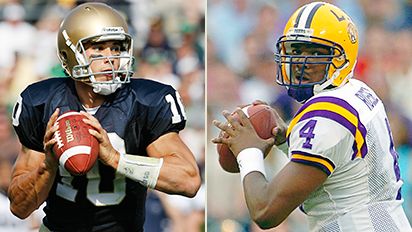 Marques Colston (pictured, left) is the most recent last-round phenom to stump the critics. He was drafted out of Hofstra in the 252nd position overall, fourth from the last player picked in the 2006 draft. He was criticized for his lack of explosiveness coming out of a route. Also, some say that he had a hard time making defenders miss after the catch. Coming from a small school did not help Colston's prospects, either.
Marques Colston (pictured, left) is the most recent last-round phenom to stump the critics. He was drafted out of Hofstra in the 252nd position overall, fourth from the last player picked in the 2006 draft. He was criticized for his lack of explosiveness coming out of a route. Also, some say that he had a hard time making defenders miss after the catch. Coming from a small school did not help Colston's prospects, either.To be fair to Colston, most scouts thought he would convert to tight-end in the NFL because of his size and his 4.5 40 time being average for a receiver. Not many predicted that he would make it as a receiver in the pros. the concern for his lack of explosiveness is considered by some to be the top evaluation factor for wide receivers. The problem today is that many wide receivers working out in the combine and during pro days are plagued with the stigma of 40 times. For some reason, a players 40 time has become the high fashion. Many team owners and coaches, particularly Al Davis, are enamored with a receiver who can blaze down the field past defenders, i.e. Randy Moss, and make the long catch. Unfortunately, not all cornerbacks are as slow as some might things and not all receivers are as good of a "ball catcher on the run," either. For a wide receiver to be productive in the NFL, speed is important but not essential. Good route-running skills, explosiveness, and the ability to adjust to the ball in the air are far better qualities to have than track star sprinting toward the end zone. Obviously, defenses would adjust to constant bombs thrown toward the endzone and play their defensive backs deeper in the formation. In this situation, quarterbacks need receivers who can separate from defenders and "go up and get it" should they need to throw a ball into the middle of the field. Colston was mis-evaluated and showed that he could do all of the things necessary to be a starter.

Another last-round hero is T. J. Houshmandzadeh (pictured, right) of the Cincinnati Bengals. Houshmandzadeh was drafted 204th overall out of Oregon State. He now is the number two receiver behind Chad Johnson and has enjoyed three straight seasons with over 900 yards receiving. Another seventh-round receiver-done-good is Donald Driver of the Green Bay Packers. Driver was drafted 213th overall has had 4 1,000 yard seasons with the Packers as one of Brett Favre's go-to-guys. Drafted in the same round and year as Driver is Hunter Smith, punter for the Indianapolis Colts. Smith has been named a Pro Bowl alternate twice is considered one of the best punters in the NFL.
Alfonso Boone, DT, and Mike Green, SS, were formerly starting teammates with the Chicago Bears. Boone recently signed a contract with the Kansas City Chiefs to be one of their starting defensive tackles, while Green now plays for the Seattle Seahawks. Both were drafted as the last two picks overall in the 2000 draft.
As it can be seen, some players do slip through the cracks, be it because of scouts' prejudices, playing at a small school, or miscalculations. There are some late-round players that go on to have extraordinary and long careers in the NFL. While the tendency has been for receivers to be misdiagnosed come draft day, there have been other position players that have enjoyed great careers. This just goes to show...The experts aren't always right.
Picture of Marques Colston taken from happynews.com.
Picture of T. J. Houshmandzadeh taken from SportsIllustrated.com.


